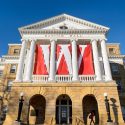Homecoming court performs public service
You’ve probably seen them waving from the back of convertibles in the Homecoming parade or being introduced at halftime, but did you know that members of the Homecoming Court perform numerous public service activities as part of their roles as ambassadors for the university?
This year members of the court have played games with the patients and painted their faces at UW Children’s Hospital, visited with the residents at Madison’s Meriter Retirement Center, and prepared and served dinner at Ronald McDonald House. They also have helped out at United Way; spent time with kids in local after-school programs and at the Salvation Army gym, and participated in the campus clean-up prior to Homecoming Week.
“Community service has been one of the favorite parts of Homecoming for court members,” says Katie Mulcahy, court co-chair. “It gives them a chance to go beyond the campus and reach out into the community, and it’s a good experience for them.”
The mission of the court is to recognize exceptional students for their outstanding service to the campus and the community, as well as for their academic achievements, says Becci Menghini, Wisconsin Alumni Association adviser to the Homecoming Committee.
Nominations for the court are sought from the university’s residence halls, athletic teams, fraternities and sororities, and other registered student organizations. Nominees must be full-time UW–Madison students who have not previously represented the university as a Homecoming court ambassador or committee member.
Court members are selected on the basis of several criteria: academic achievement and honors; Badger pride and enthusiasm for the University of Wisconsin; community involvement and service; leadership skills and extracurricular activities; and the overall impression and interaction they exhibit during the interview process.
A panel of judges interviews the finalists and shares its impressions with the Homecoming chairs, who make the final selections. The judges range from faculty and staff to members of the business community and alumni.
Homecoming advisory board member and alumna Keri Robbins, who has been a judge for several years, says she looks for students who have a balance of accomplishments inside and outside of the classroom.
“I look for those who can just as easily tell me about their academic research as their leadership roles in student organizations,” says Robbins. “These students are – without exception – bright, accomplished, enthusiastic and positive about their experiences on campus, and truly delightful to meet.”
Each court member is expected to attend all Homecoming-related functions, which involves a substantial time commitment – approximately 10 hours during the week before Homecoming and 30 hours during Homecoming Week. Court functions include all scheduled Homecoming Week events, community service projects and public appearances.
The court’s activities are not the only community service performed as part of the Homecoming celebration. The university’s Morgridge Center for Public Service and the Homecoming Committee have teamed up to provide more than 80 community service opportunities for groups participating in the Homecoming competition.
In addition, a Homecoming blood drive is held each year, and the annual Charity Run/Walk, Homecoming golf outing and other events raise thousands of dollars for the Dean of Students Crisis Fund and the WAA/Homecoming Scholarship Fund. The Dean of Students Crisis Fund helps students who are in need of emergency finances.



